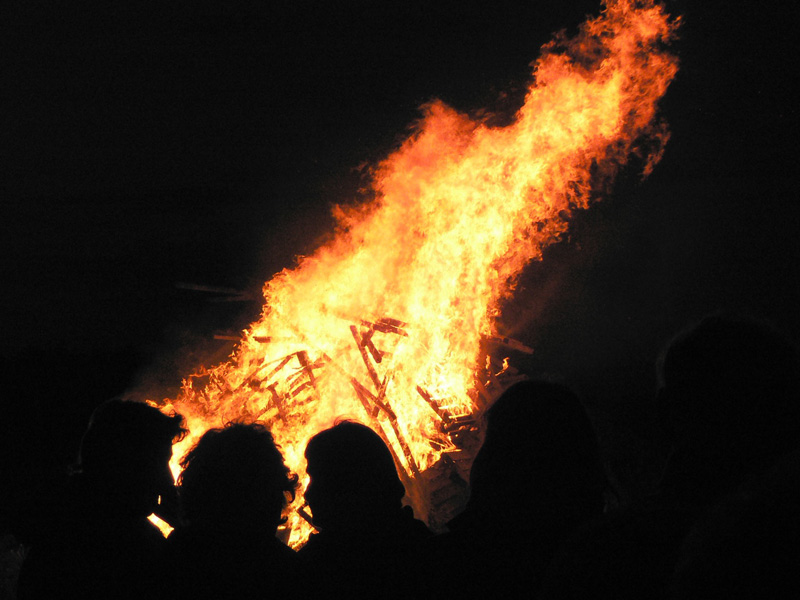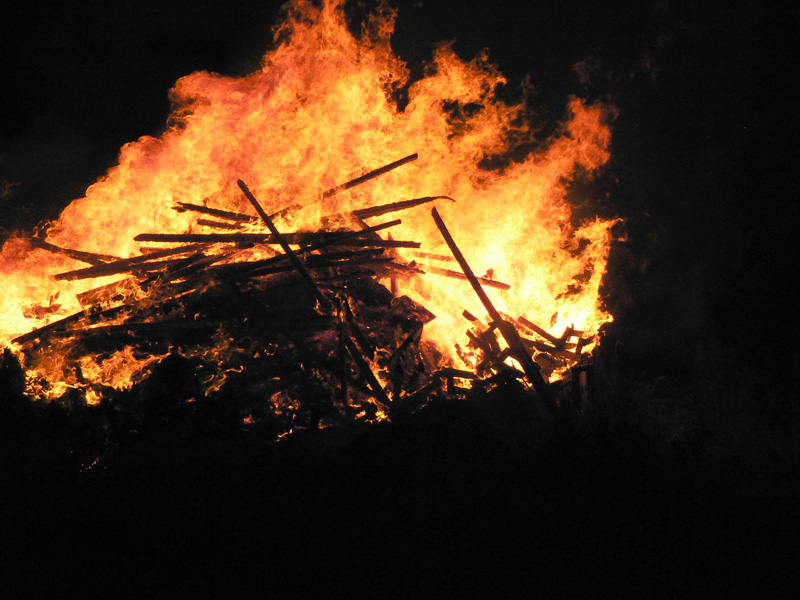Bonfire of the Baptist
Wednesday, 17 September, 2014. Filed under: Cornwall | Strange Days

At the end of a long journey into Cornwall, crumpled into a corner of a train, I was longing to get out on the open moor. Aside from the cattle truck stylings of British rail travel, the journey only reinforces the impression that Cornwall is a very long way from anywhere. And, along with the promise of witnessing an event that, though once widespread, only occurs now in Cornwall, it is this remoteness that brings me here.
“Here” turns out to be somewhere between Penzance and Zennor in a field near the hamlet of Boswarthen which is, itself, to be found just off an isolated road north of Madron. Despite the abundance of placenames, each of which sounds like the grave syllables of a mumbled prayer, I am effectively bang-slap in the middle of nowhere.
I’m here for a bonfire, specifically a midsummer’s eve bonfire on top of a hill overlooking Mounts Bay – one of at least half a dozen such events arranged by local Old Cornwall Societies up and down the county. The guiding principle of these societies is to hold on to the old customs and keep them alive for the next generation – a process of ‘gathering the fragments’ of Cornish culture, language and traditions which has steadily grown in popularity over the years. Sure enough, the secluded lane quickly fills with parked cars as organisers and spectators turn up, almost all at once. People of all ages are here, from the local Young Farmers who are having a barbecue in the back of a horse box, to a strong contingent of senior villagers.
“Health and safety would probably want us to put up a barrier around that”, says Roy Matthews, Honorary Chairman of the Madron Old Cornwall Society, waving in the general direction of a 12 foot high pyramid of old pallets and fertiliser bags. “But the thing with a fire is that it’s hot, you see. Nobody’s going to be able to get anywhere near it once it’s lit.”
He goes on to explain some of the history of the bonfires. Thousands of years ago, animal sacrifices would be made on them. “Sometimes, they’d throw the odd criminal on”, says Matthews, with a playful gleam in his eye, “but now we throw a wreath on instead.”

By about 9 pm, around seventy people have crowded into the small field. The air is thick with the smell of the horse box burgers, dozens of conversations have coalesced into a soft murmur, at which point we are handed our photocopied song sheets – along with a steely warning to return them later. We are to be accompanied by the parish priest, the Rev. Tim Hawkins who, rather than appear here in an official capacity, has brought his viola along instead.
At first I mouth the words, like a self-conscious schoolboy in morning assembly, as I don’t wish to appear impolite, but I am eventually swept up in it all - the beautiful location, the camaraderie and the life-affirming spirit of a sing-along at 700 feet. Undaunted by my lack of vocal talent, I join in with Hail to the Homeland and Going Up Camborne Hill, Coming Down and my mind is elevated from its usual default settings. I have become one of them.
As night draws in, and with the final chorus of Trelawney still ringing in my ears, the ceremony begins in earnest with the reading of the prayer – first in Cornish, then English. When the ancient Celts were converted to Christianity, the fires were transformed, with the early Church’s usual resourcefulness, into celebrations of the Feast of St John the Baptist. As a result, every bonfire now has a benediction which includes a couple of priceless puns about “being lighted by Thy grace and fired with Thy love”.
After a brief explanation of the symbolism of the bouquet of herbs that are to be thrown in to the fire – in place of a local ne'er-do-well – and some words from the Master of Ceremonies, a man appears with a bottle of white spirit to set things off in style. It’s only moments before the pyre is blazing furiously away, its wild flames clawing at the inky blue-black sky. For all the layers of ceremony, etiquette, poetry and faith superimposed over the night, the fire itself is the focus and this is as it would have been for our ancestors, a celebration of summer through the building of a simulacrum of the sun itself.
Clinging onto those thoughts, I wind down the narrow lane home. A Cornwall Fire Brigade engine with sirens screaming and blue lights blazing appears from nowhere, heading in the direction of the flames I have left behind. For all the efforts of the organisers, it seems that the wild old and the ordered new Cornwall are yet to be reconciled.
blog comments powered by Disqus
